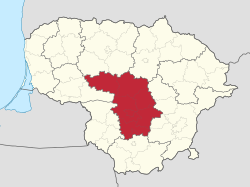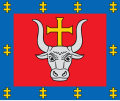You can help expand this article with text translated from the corresponding article in Lithuanian. (January 2011)Click [show] for important translation instructions.
|
Kaunas County Kauno apskritis | |
|---|---|
From the top to bottom-right: Kaunas Old Town, Kaunas Castle, Birštonas spa town, Darius and Girėnas Stadium, Žalgiris Arena. | |
 Location of Kaunas County | |
| Country | |
| Administrative centre | Kaunas |
| Municipalities | |
| Area | |
• Total | 8,086 km2 (3,122 sq mi) |
| (12.4% of the area of Lithuania) | |
| Population (2022) | |
• Total | 623,262 [1] |
| • Rank | 2nd of 10 (20.4% of the population of Lithuania) |
| • Density | 77.08/km2 (199.6/sq mi) |
| GDP | |
| • Total | €14.7 billion (2023) |
| • Per capita | €25,200 (2023) |
| Time zone | UTC+2 (EET) |
| • Summer (DST) | UTC+3 (EEST) |
| ISO 3166 code | LT-KU |
| HDI (2023) | 0.901 [3] very high · 2nd |
 | |
Kaunas County (Lithuanian : Kauno apskritis) is one of ten counties of Lithuania. It is in the centre of the country, and its capital is Kaunas. On 1 July 2010, the county administration was abolished. [4]






